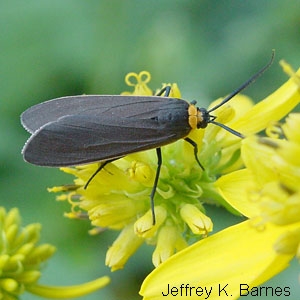Yellow-collared scape moth
Order: Lepidoptera
Family: Arctiidae
Genus and species: Cisseps fulvicollis (Hübner)
The yellow-collared scape moth is distinctive and unusual in that it is one of few moths that fly during daylight. Because it is vulnerable to visual predators, it must have special protections in order to survive. The moths are black with a yellow or orange “collar” suggestive of aposematic or warning coloration. Perhaps individuals sequester poisons from food plants, and they are warning potential predators not to eat them. Some authors suggest the moths are mimicking dangerous wasps or other insects, or they may be wholesome moths mimicking unwholesome moths.
Adults are seen in summer and fall, consuming nectar from milkweed and composites, such as goldenrod. They are about 3/4 inch long and have a wingspan of about 1 ½ inches. The body is bluish black with an orange or yellow collar, depending on geographic location (more yellow in the Midwest). The fore wing is black with a yellow streak extending along the outer basal half. The hind wing, which is rarely seen, is translucent except for the black margins and veins. Adults might be confused with those of another, slightly larger arctiid moth, the Virginia ctenucha. However, the head of the latter species is orange or yellow, whereas the head of the scape moth is black. The scape moth also might be confused with the considerably smaller grapeleaf skeletonizer moth, but in the latter species the abdomen is usually curled upwards and expanded at the tip into a fan-shaped, somewhat bilobed caudal tuft.

Larvae vary from yellow to brown to nearly black and have a reddish orange dorsal stripe and broad black lateral stripes. They are covered with somewhat sparse, pale, silky setae. The head capsule is orange. The larvae are nocturnal, feeding on grasses, sedges and lichens near ground level. Cisseps fulvicollis spends the winter as half grown larvae.
This common moth ranges from southern Canada to the Gulf States and west to the Rocky Mountains and Chihuahua, Mexico. It occurs throughout Arkansas.
A scape is defined as stalk. The name “scape moth” might refer to the long, scapelike stalk at the base of each antenna.
